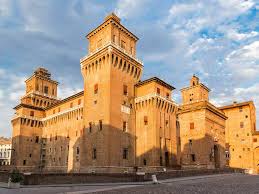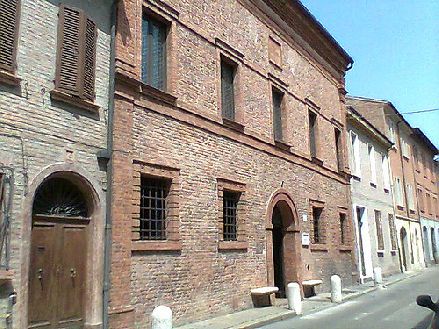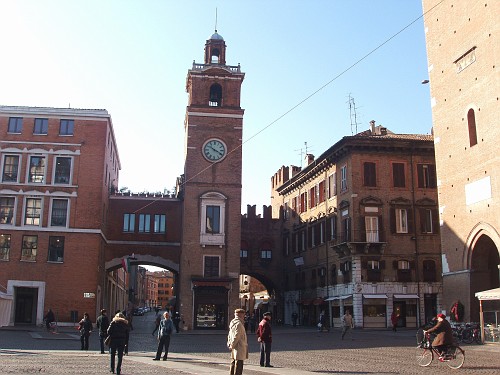The city of Ferrara is located on the banks of the Po Volano, in the lowlands of Emilia. This magnificent city has preserved over the centuries prestigious taken during the age of Este. It is in fact the family d'Este which has the ambitious urban development project that transformed the medieval citadel from Ferrara in a real Renaissance work. The great cultural season of the Este began in 1391 with the founding of the University and grew to the point of bringing the Este court at the highest levels europei.Ferrara Piazza Trento and TriesteIn city came humanists and artists of the rank of Leon Battista Alberti, Piero della Francesca and Titian. Even great writers such as Boiardo, Ariosto and Tasso wrote verses to honor the great Dukes of Este. Even today in Ferrara, thanks to the development plan wanted by Ercole I d'Este, it captures the spirit of the Renaissance and the evocative fusion of new and old. The project of the Herculean stems largely recognized that UNESCO has included in the list of UNESCO World Ferrara.
Estense Castle:
It is the majestic symbol of Ferrara with its four towers surrounded by a moat, the red brick floors, elegant balustrades white, prisons and salt for the games and the pleasure of the court. Acre park, which with its beauty crowns the city of Ferrara, the emblem of which they are proud of Ferrara, was built against the citizens themselves. In 1385 the crowd, exhausted by hunger and poverty rose up in mass killing Tommaso da Tortona, a hated magistrate Judges dei Savi. So he galvanized the people tried to stifle the monarchy of the Este family, owner of Ferrara. Nicholas II after he was terrified as he was changing the fate of his family, had the coolness to take time and while he built a castle to defend himself from the fury town. The task was entrusted to Bartholin from Novara who began work incorporating the Torre dei Leoni, north, ending the building in no time, only two years. The castle has a square and four square corner towers. Still has a moat filled with water ... strange to think that served to alienate their own people! As a defensive fortress was a real model and was studied and admired by many architects, including Michelangelo himself. Underwent several restorations to date, the most important came in after a fire in 1554 and a devastating earthquake in 1570. In 1476, when the castle was in the hands of Ercole I and his wife Eleonora of Aragon, it was internally restored and embellished, work which was continued by his successors who willingly engaged the likes of Titian, Raphael, Giovanni Bellini. Then with Hercules II, in the mid '500, the castle was transformed permanently in court palace, assimilating the aspect that we can see today.

Scopri di più Torna sù
Cathedral Square:
Cathedral Square (or Piazza Duomo) is bounded by the front of the Cathedral, the Palazzo della Ragione with Aleotti Tower, the Victory Tower, the Ducal Palace, now the Town Hall, and finally the Archbishop. The buildings in the crown of the square were the same, but before the war loomed, the center, the austere figure and mustache of King Vittorio Emanuele II, a bronze monument erected in 1889 by sculptor Giulio Monteverde. At the foot of the sovereign, another figure, also in bronze, representing Italy. The antics of Ferrara were often turned so disrespectful to the statue that was ridiculed as the "peg"; when the monument was removed, the square regained his breath, depth and freedom he always enjoyed. No one remembers the horse-drawn tram that were stopped in front of the Cathedral, but starting from 1910 came into operation the electric tramway and a clanking convoy made its regular stop in front of the Duomo: the past and other speed lucky today, mind mitigated, at least in the old town, a pedestrian in reality not always respected. The arc of the horse, attributed to Leon Battista Alberti, was leaving a loggia which - extending north - conformed the architectural layout of the square unifying the palace wall Este facing the Cathedral. Ferrara so I could walk around comfortably throughout the perimeter of the square, away from the vagaries of weather, but also could see an architectural more harmonious fluent in the three plazas consist Piazza Trento Trieste, the Cathedral Square and Piazza Savonarola.

Torna sù
Town Hall:
The Palazzo Ducale Estense (now the Town Hall), is currently owned by the City of Ferrara. It was built in the thirteenth century by the Este family, lords of Ferrara in 1264, who wanted to establish their residence. The noble building was erected in front of the Cathedral (1135), around which just at that time was consolidating the center of the city power. The building was originally made up of the body of the building on Via Cortevecchia and the front of the Cathedral. The building was inhabited by the Este family until 1598, when Ferrara came under the direct rule of the Papal States; since that time the palace, while remaining for a long time partly owned ducal ceased its destination of residence of the Court, and then become an architectural complex dispersed among several nominees, to be primarily aimed at the Residence Hall. The building is therefore affected the various changes over the centuries. Just in front of the porch of the Cathedral is the Face of the Horse; the sides of this old entrance of the Palace of the Court, are a refined bow and a column on which are located respectively the Marquis Nicolò III on horseback and the Duke Borso d'Este sitting on faldistorio. The Face of the Horse leads to Piazza Municipale (former Courtyard Ducale). Piazza Municipale affects both the majestic staircase, built by the ducal Pietro Benvenuti in 1481, the Chapel of the Court (Sala Estense today), built in the second half of the fifteenth century. The interior has numerous prestigious environments. Salt and interiors: The majestic staircase leads to the main floor, where you can see two large halls with ceilings and decorations of the sixteenth century. In this wing of the building, Ercole I d'Este in the second half of the '400 had made up the so-called "Great Hall" for parties and theatrical performances. Among the areas of interest, in addition to the Golden Room (XV century), the Duchess of Camerino well it represents the taste and refinement of the Este. It is a small "closet", a "treasure chest" expertly decorated between 1555 and 1560. In the Hall of Tapestries, however, they are exposed two valuable Flemish tapestries of the early seventeenth century. The environment, great-looking, is considered a masterpiece of the twentieth century and offers the visitor a real exaltation of the mythical and legendary aspects of Ferrara.
Torna sù
Ariosto’s House:
The House of Ludovico Ariosto, who hosted the famous poet in the last part of his life, is located today in the addition Erculea in Ferrara, Via Ariosto 67. It is a simple brick building, probably built on a design by Girolamo da Carpi. Here Ariosto spent the last years, devoting himself to the third and final drafting of the Orlando Furioso, 1532. Inside the main floor it is placed a small museum dedicated to the great poet: there are a cast of inkstand, his chair and various medals that depict him as the one found in his tomb when it was inspected in 1801. In the central corridor is exposed a copy of Orlando Furioso illustrated by Gustave Doré in 1881. In the room to the left, where there is an elegant fireplace, exposed a bust and a portrait of the nineteenth century. In addition to the museum building is teeming with events, presentations of books, contemporary art exhibitions and concerts. Behind the house is a garden created at the time of the poet, today this also used for concerts and temporary initiatives

Torna sù
Clock tower:
This beautiful tower is the centerpiece of the village life for the inhabitants of Comacchio is located near the Loggia del Grano. E 'was built around 1330 and then after 500 years suddenly collapsed for reasons not well specified. In 1824 the tower was rebuilt, has a square plan then becomes octagonal and is almost entirely built in brick has a height on the side that faces away Folegatti the center of the tower there is a niche that houses a statue of the Virgin Mary (Our Lady of the Visitation) by the Ferrarese Francesco Vidoni. Above the niche it is place the clock that marks the passing of time in this beautiful country that deserves to be visited.

Torna sù
Corso Ercole:
Corso Ercole I d'Este of Ferrara is a historic street and one of the most important cities. The street in the old part of the Herculean project, commissioned by the Duke of Ferrara Ercole I d'Este and commissioned Biagio Rossetti. Work planning work began in 1492 and ended around 1510 and involved the direct unification between the south of the old town, where is located the Castello Estense in the northern part of the walls up to the door of the Angels. The long driveway that was thus created was named Avenue of the Angels and the intersection with a cross street from the east came to form the "Crossroads of the Angels" formed by the Palazzo dei Diamanti, Palazzo Prosperi-Sacrati and Palazzo Turks bathroom. We are located, as well as the Palazzo dei Diamanti, Palazzo Prosperi-Sacrati Turks and Palazzo di Bagno, the palace of the pawnshop, the avenue leading to the Certosa Certosa di Ferrara, at n. 3 The MLB Home Gallery of Maria Livia Brunelli, house - contemporary art gallery, the High School citizen A. Roiti, palaces Trotti Mosti Estense and Giordani, at the intersection with Via Arianuova and via Guarini, headquarters of the Department of Law of ' University of Ferrara and the Centre for Documentation and Studies on the European Communities, and an entrance of the park Massari. Moreover, given the current state identical to the medieval, is the European way longer without shops.
Torna sù
The Diamond Palace:
The palace was designed by Biagio Rossetti on behalf of Sigismondo d'Este, brother of Duke Ercole I d'Este, in 1492. The actual construction took place between 1493 and 1503. The building was modified between 1567 and 1570 by Galasso Alghisi (sometimes referred to as Galeazzo Alghisi or Galeazzo from Carpi), such interventions could, according to some scholars have covered the brick fascia that crowns the building, entering the balcony corner, the shape and arrangement of the windows facade. The palace was inhabited intermittently from the house of Este components until the devolution of Ferrara to the Holy See took place in 1598. In particular, since 1586 was the residence of Cesare d'Este, cousin of the Duke Alfonso II d'Este and its wife Virginia de 'Medici, daughter of Cosimo I and Camilla Martelli. In this period they were decorated three rooms that overlook the course Biagio Rossetti (the ancient road of Saint Benedict or prions) and which formed the apartment of Virginia de 'Medici. The coffered ceilings and friezes of the 'master bedroom' (1589 - 1590) and the "room of childbirth" (1591) were made primarily by Giulio Belloni and aid and are still visible on site. Other paintings on canvas made by Carracci and Gaspare Venturini for the "balcony room" (1592) are now preserved at the gallery Estense Modena. Always gallery Estense Modena is a series of four rectangular canvases attributed to Gaspare Venturini, other parts of the cycle now belong to private collections, depicting allegories from "dressing" of the books of Caesar. The dressing room has been suggested he was in the south wing of the building on the ground floor and the decorations were made between 1592-1593. In 1641 the building was sold by Francesco I d'Este, nephew and successor to the Marquis Guido Cesare d'Este The Villa. The new owners will change the entrance by running the moldings and the two candelabra side. Several portraits of members of the family villa can still be seen in the entrance hall of the gallery. In 1832 the building was purchased by the city of Ferrara in order to accommodate the Art Gallery and the University Civic.
Torna sù